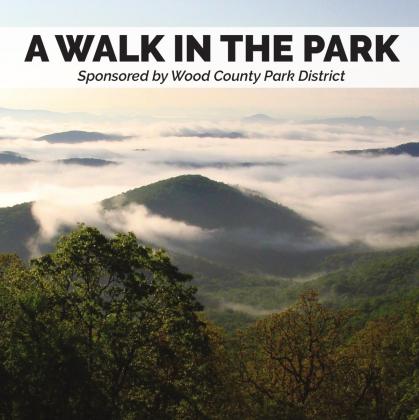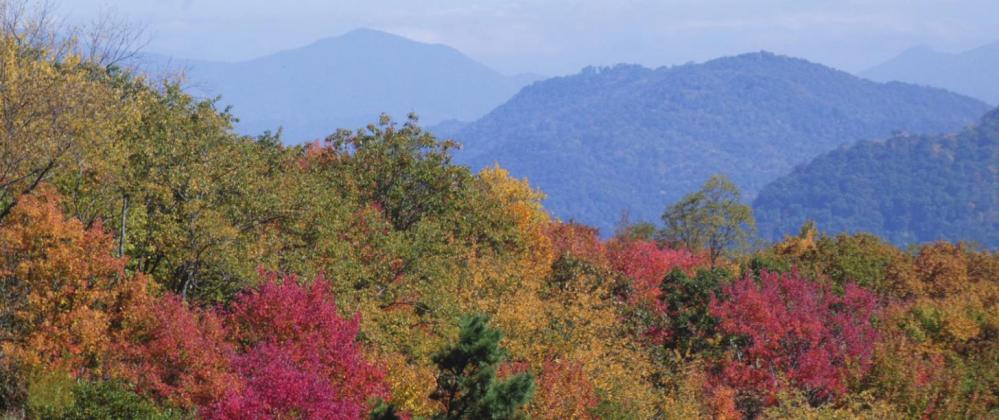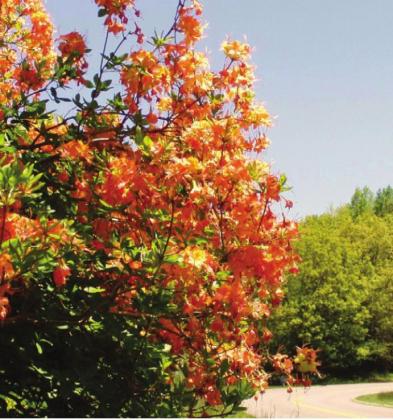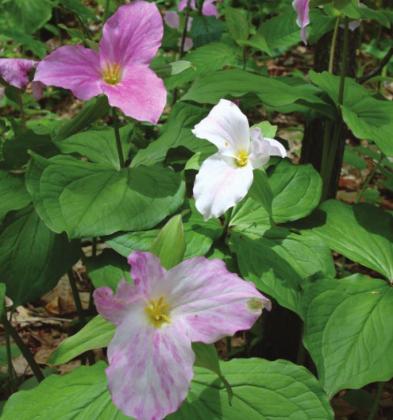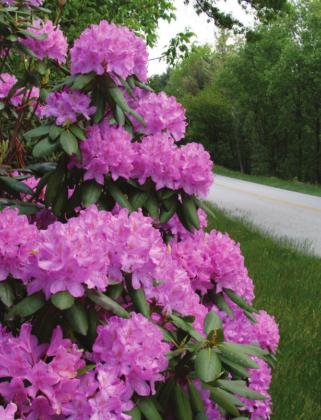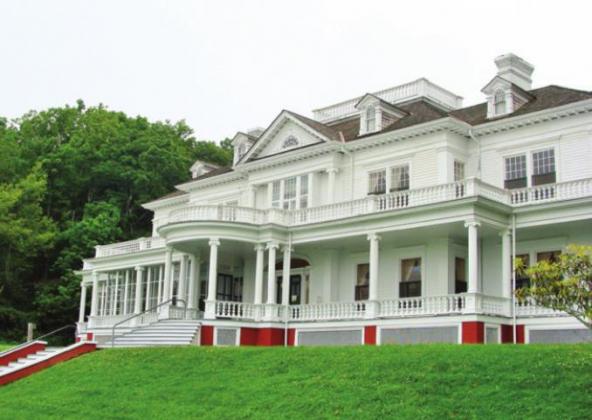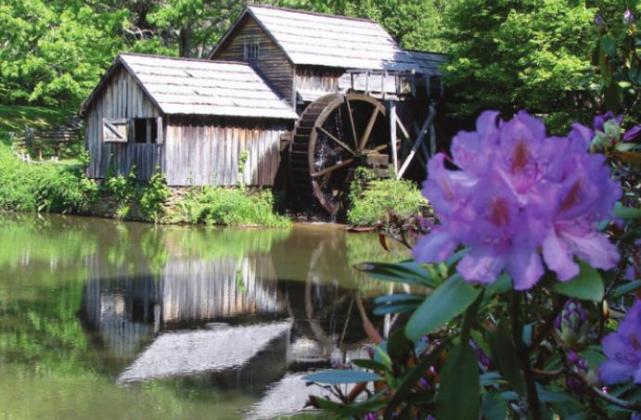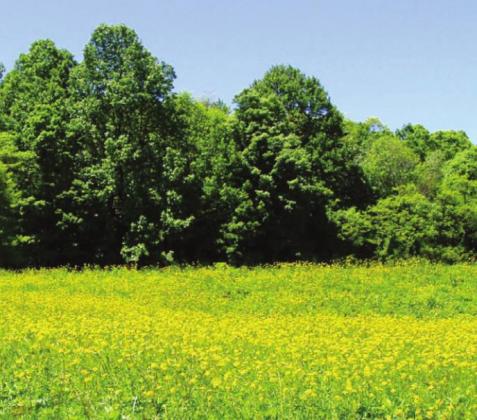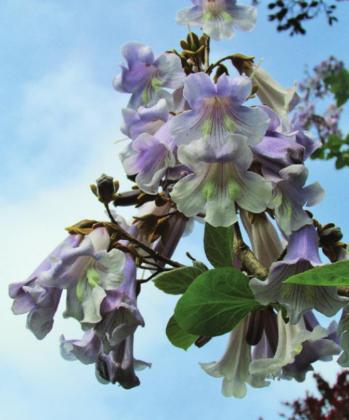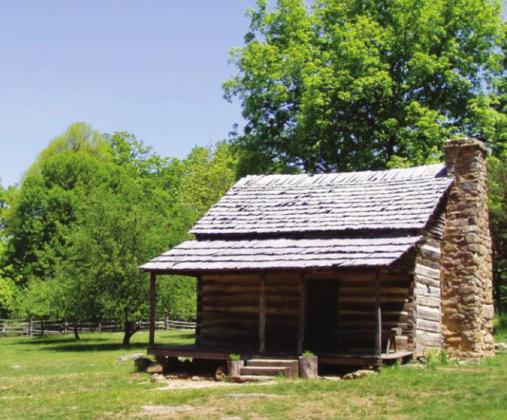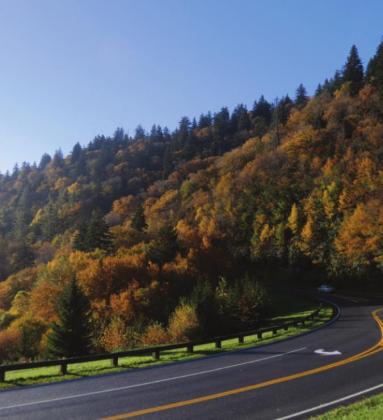A Walk in the Park
by LeMoyne Mercer
LAST MONTH I MENTIONED that one of our favorite trips in fall or spring is to Great Smoky Mountains National Park and up the Blue Ridge Parkway to Shenandoah NP. Or vice versa. When I left off, we had been to Cades Cove in the Smokies for four days and were at the southern terminus of the Parkway.
As you undoubtedly recall, the Blue Ridge Parkway is itself a 469-milelong and narrow national park that runs mostly along the crest of the mountains through North Carolina and Virginia. Much of the Parkway is bordered by national forest, but there are stretches where farm land comes right up to the road. There are 280 pullouts where you can pause to appreciate marvelous views across the Shenandoah Valley to the misty Allegheny Mountains in the west or the Piedmont to the east. For that matter, you can pull over anyplace you can get safely off the road. Short, easy nature trails are found at every major overlook. There are eight waterfalls that can be reached by park trails and many more, lost in dense forest and undergrowth, that are accessible only by squirrels and raccoons. The Appalachian Trail mostly parallels the Parkway but winds back and forth across it. The AT is most often reached via connecting Forest Service trails from the Parkway. Whether you are young and athletic or a fall leaf peeper or spring wildflower lover, there is something for you.
From Cades Cove, Shirley and I crossed the Smokies via Newfound Gap Road and went 60 miles up the Parkway to Mt. Pisgah Campground. Now, that may seem like a short day, but the maximum speed limit is 45 mph with many sharp curves where it drops to 25 or less. In compensation, there is some form of visual delight around every turn. You probably wouldn’t stop at all of the pullouts, but the whole point of taking the Parkway is to admire the view, so we stop often. For people in a hurry, I-81 is just a few miles to the west. Most visitors don’t do the entire 469 miles, so the interstate and numerous state and county roads make it convenient to drive as much or as little of the Parkway as you choose.
We had reservations at Mt. Pisgah for two nights through recreation. gov. Fortunately, we have been there before and know what the campground is like. Also, I keep a file of campground maps from places we have visited and may wish to return. We circle the numbers of sites we find attractive because of the location of rest rooms and/or showers, easy back-in or pull-through, shade or sun, proximity to neighbors, and level so we don’t sleep with our feet higher than our heads. The algorithm at recreation.gov doesn’t know or care about what is important to us. Before COVID, we could just drive through a campground and choose a site that met our requirements. Now it is necessary not only to choose arrival and departure dates far in advance but also to commit to a specific site unseen—so to speak.
For those not interested in camping, there is a park lodge just across the road with a balcony and private porches from which to soak up the view. Another lodge is at Peaks of Otter farther north. There are also towns and cities all along the Parkway with commercial establishments. Little Switzerland is a particularly good example—if you appreciate a European vibe in North Carolina.
Mt. Pisgah, at about 5,000 feet, is the highest of the eight campgrounds on the Parkway. In summer, this means it is pleasantly cool. In fall and spring, it might even be a little too cool depending on what you like. When we were there, the overnight lows were 40 and 47—what we call good sleeping weather with the windows open. That elevation also means that fall color arrives sooner than down at Linville Falls at 3,000 ft. or Otter Creek at only 800. Conversely, spring wildflowers arrive later. So, if you travel the entire Parkway through changing elevations and latitudes, you will notice wide variations in the foliage whatever the season.
About 25 miles north of Pisgah is Asheville, NC where the main attraction is the modest summer cottage of George Washington Vanderbilt. He was so struck by the natural beauty of the area that he built the 255- room French Renaissance chateau you probably know as the Biltmore Estate. We recommend it highly for the Michaelmas Fall Harvest Festival and springtime in the gardens. George’s house is pretty nice, too. For some reason, my blog post on the Biltmore is even more popular than those on the Canadian Rockies and Alaska. Perhaps because Biltmore is a somewhat shorter drive.
Another ten miles north of Asheville is a quite different experience. The Folk Art Center has a museum and gift shop featuring traditional mountain crafts, such as quilting, carved wood bowls and utensils, blown glass, metal working, and pottery. There are daily crafts demonstrations and a chance to talk with the artisans. Note that these crafts have been raised to an exceptionally high level and fully justify their designation as art. Prices reflect their quality.
Yet another ten miles gets you to Craggy Gardens. In fall, the mountain ash with bright orange berries put on a colorful show. Frankly, though, we prefer the rhododendrons, azaleas, and mountain laurels of spring. That’s why it is called Gardens. There is a half-mile trail out to Craggy Pinnacle where you may see the annual migration of hawks. They ride the powerful mountain updrafts to cover great distances while scarcely lifting a feather. Those updrafts, though, carry the hawks so high they often become mere specks. The migration is visible from just about any overlook that is close to the spine of the mountains. Which is to say all of them.
Sometimes our next stop is at Crabtree Meadows because there is a short but fairly steep trail down to the falls. We prefer the falls in the spring when mist from the falls promotes the growth of trilliums.
This year we had reservations at Linville Falls where a trail along the bluff leads to five clearings from which to get different perspectives. There is no single place from which you can see the entire spectacle because Linville is a double falls. Water from the cascades upstream is funneled through a deep, narrow crack in the rocks and drops 15 feet before disappearing around a sharp bend. You need to continue to the next viewpoint to see it re-emerge for a thunderous drop of another 45 feet. When Shirley and I were much younger, we climbed down the bluff to the base of the falls and managed to get disoriented for a while in an impenetrable rhododendron thicket. Since then, we have stuck with the mile-and-a-half trail along the bluff.
At Mile Post 290 is the Moses Cone estate, Flat Top Manor, based on the same concept as the Biltmore though on a somewhat less extravagant scale. The Manor is a mere 23 rooms that Cone filled with art from Asia. The grounds included two lakes Cone had dug and 25 miles of carriage trails through a park-like setting. Flat Top Mountain and Rich Mountain were landscaped with maples, hemlocks, and pines much as Vanderbilt created his own forest of selected trees. The Manor porch overlooks the remaining apple orchard where Cone used scientific methods to cultivate 29,000 trees of 75 varieties. The Parkway Craft Center, like the Folk Art Center, preserves and promotes the practice of traditional crafts and has artisans who demonstrate their skills.
Farther north is the Blue Ridge Music Center with a nice museum and performance hall for traditional mountain music concerts. When a concert is not scheduled, the hall is open for the informal jam sessions of amateur but highly skilled musicians. Please note: this is definitely not Country-Western music and if you think you wouldn’t care for Mountain Music you are probably mistaken. Under normal circumstances, Shirley and I prefer classical and jazz, but good music is good music regardless of the genre.
Our next stop, and the one we never miss, is at Mabry Mill. Not only is the mill picturesque, but there are, in non-COVID years, demonstrations of the miller’s art and that of his col league just a few yards away in the blacksmith shop. We always have a down-home meal at the restaurant just across the mill pond. It is typically breakfast when we are southbound or supper if headed north. We stay a few miles up the Parkway at Rocky Knob Campground for convenient access to the mill and for its marvelous displays of flame azaleas in the spring.
By the time you read this, Shirley and I will have completed our Smokies, Blue Ridge, and Shenandoah circle tour, and it is probably too late in the season for you to catch the peak fall color. But we think the color is even more marvelous in the spring, so let’s contemplate that for a while.
There are wildflowers in small patches and great swaths virtually anywhere there is a break in the canopy of trees. At least 200 varieties have been recorded, of which the yellow and gold seem to predominate—ox eyes, golden asters, blackeyed Susans, coreopsis, mouse ears. Eventually, Shirley decided that anything yellow we didn’t recognize immediately was just “a member of the hawkweed family.” Wildflowers in blue, red, purple, and white are too abundant to even begin listing. There are breathtaking vistas all along the Parkway, but some of the most beautiful things you will see are literally right at your feet.
Or just a little higher. Flowering trees and shrubs line the road—redbuds, dogwoods, mountain laurels, azaleas, rhododendron, tulip poplars, Paulonias, miles of white-flowered blackberry bushes. One of our favorite trees is the black locust. The flowers themselves are not especially impressive, but they do spread an intense perfume for an amazing distance. You know there is a locust somewhere around even if you can’t see it.
Though the glories of the natural environment dominate the Parkway, as in the Smokies, attention is also given to the historical heritage of the region. That is, there are pioneer cabins and, at Humpback Rocks near the northern terminus, the Mountain Farm Museum, which is not a building but an actual pioneer farm. In addition to the log cabin, there is a barn with bear-proof pig pen, a weasel-proof chicken coop, a root cellar for storing vegetables, and a spring house where the cool mountain water helped preserve food. My favorite thing about the farm is that it was purchased by William Carter in the late 1800s for three dollars an acre. In Confederate money. Which was worth only slightly less than Monopoly money. Evidently, the seller believed Carter when he said “The South shall rise again.”
Adjacent to the farm is the Visitor Center. Six miles north of that is the end of the Blue Ridge Parkway and the beginning of Skyline Drive through Shenandoah National Park. I spell out “National Park” because I have spoken with a surprising number of people who have heard of Shenandoah, VA and the Shenandoah Valley but were totally unaware that there is a park by that name. Undoubtedly, you are not a member of the Tribe of the Totally Unaware. And you already have guessed where we will take our next walk in that park.
LeMoyne Mercer is the travel editor for Healthy Living News. If you are contemplating a trip, you might want to see pictures of numerous destinations on his blog, anotherwalkinthepark@blogspot.com. ✲

